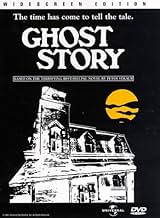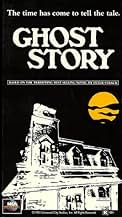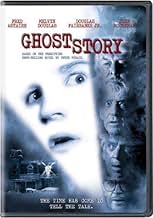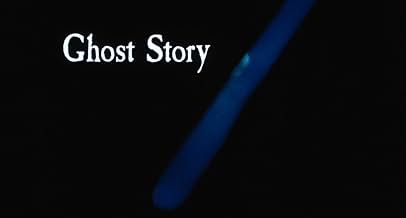Two generations of men find themselves haunted by the presence of a spectral woman. When the son of one of the elderly men returns to his hometown after his brother's mysterious death, they ... Read allTwo generations of men find themselves haunted by the presence of a spectral woman. When the son of one of the elderly men returns to his hometown after his brother's mysterious death, they attempt to unravel her story.Two generations of men find themselves haunted by the presence of a spectral woman. When the son of one of the elderly men returns to his hometown after his brother's mysterious death, they attempt to unravel her story.
- Awards
- 3 nominations total
- Director
- Writers
- All cast & crew
- Production, box office & more at IMDbPro
Featured reviews
I will take you places you've never been. I will show you things that you have never seen and I will see the life run out of you. ~ Eva, in the film Ghost Story
The movie centers on a group of elderly men who have formed an exclusive story-telling group called The Chowder Society. The men meet regularly, sit around a fire in a dark room and share their best ghost stories. Under the surface, however, lies a ghastly secret they all share - a real life, true ghost story of their own that they dare not speak of.
When one of The Chowder Society member's twin sons dies in a very strange and inexplicable accident, the other twin returns home to mourn with his father. That is when a series of horrifying events begin to unfold, forcing the men of the Chowder Society to come to terms with the shocking and dreadful event that has haunted them for the past 50 years.
I personally love these types of stories. They do not feature masked- maniacs hunting down unsuspecting teenagers and hacking them to death. (Although there are a few good ones in that category!) What this story does provide is a genuine chill-running-down-your-spine sensation that brings you to a terrifying place without ever forcing you to close your eyes.
A star-studded cast includes Fred Astaire, Melvyn Douglas, Douglas Fairbanks, Jr., John Houseman and Patricia Neal, Jacqueline Brookes, Craig Wasson and Alice Krige. Having a cast with such experienced and talented actors creates a believable and authentic film making it a worthwhile, scary little gem of a movie.
If you like genuine ghost stories, watch this movie. Based on the novel by the gifted Peter Straub and skillfully directed by John Irvin, this film is a top pick for me.
The movie centers on a group of elderly men who have formed an exclusive story-telling group called The Chowder Society. The men meet regularly, sit around a fire in a dark room and share their best ghost stories. Under the surface, however, lies a ghastly secret they all share - a real life, true ghost story of their own that they dare not speak of.
When one of The Chowder Society member's twin sons dies in a very strange and inexplicable accident, the other twin returns home to mourn with his father. That is when a series of horrifying events begin to unfold, forcing the men of the Chowder Society to come to terms with the shocking and dreadful event that has haunted them for the past 50 years.
I personally love these types of stories. They do not feature masked- maniacs hunting down unsuspecting teenagers and hacking them to death. (Although there are a few good ones in that category!) What this story does provide is a genuine chill-running-down-your-spine sensation that brings you to a terrifying place without ever forcing you to close your eyes.
A star-studded cast includes Fred Astaire, Melvyn Douglas, Douglas Fairbanks, Jr., John Houseman and Patricia Neal, Jacqueline Brookes, Craig Wasson and Alice Krige. Having a cast with such experienced and talented actors creates a believable and authentic film making it a worthwhile, scary little gem of a movie.
If you like genuine ghost stories, watch this movie. Based on the novel by the gifted Peter Straub and skillfully directed by John Irvin, this film is a top pick for me.
When this film was first released, it was greeted with a sense of disappointment. Many felt it did not do Peter Straub's source novel justice.
I thought this was an unfair judgement at the time, and watching the film again today confirms this belief. "Ghost Story" does not attempt to emulate the complexity of Straub's epic tale : that would have been impossible. But it does distil the essence of that story - four ageing men haunted by a terrible tragedy from their youth - and puts it on screen with chilly precision.
With some masterly photography and a recurring motif of running water (most dramatically in the truly scary bathtub scene), Irvin imbues the film with a real chill of the grave feel. The ending, as Alma descends the staircase of her decaying house in her wedding dress, isn't a gorefest : there are no elaborate effects or dramatic battles between good and evil. But it is subtly terrifying nonetheless.
Just about all the IMdB reviews, good or bad, have praised Alice Krige's performance. For such a young actress, she's simply stunning. It's a brave, brilliant portrayal. A feminist reading of the film could argue that the real horror lies in the inability of men (and especially the callow youngsters featured in the 20s flashback) to cope with a powerful, sexually-assertive woman.
This is a clever, stylish film which lends itself to differing interpretations. It creates more elegant frissons of fear than almost any other 80s horror film.
I thought this was an unfair judgement at the time, and watching the film again today confirms this belief. "Ghost Story" does not attempt to emulate the complexity of Straub's epic tale : that would have been impossible. But it does distil the essence of that story - four ageing men haunted by a terrible tragedy from their youth - and puts it on screen with chilly precision.
With some masterly photography and a recurring motif of running water (most dramatically in the truly scary bathtub scene), Irvin imbues the film with a real chill of the grave feel. The ending, as Alma descends the staircase of her decaying house in her wedding dress, isn't a gorefest : there are no elaborate effects or dramatic battles between good and evil. But it is subtly terrifying nonetheless.
Just about all the IMdB reviews, good or bad, have praised Alice Krige's performance. For such a young actress, she's simply stunning. It's a brave, brilliant portrayal. A feminist reading of the film could argue that the real horror lies in the inability of men (and especially the callow youngsters featured in the 20s flashback) to cope with a powerful, sexually-assertive woman.
This is a clever, stylish film which lends itself to differing interpretations. It creates more elegant frissons of fear than almost any other 80s horror film.
... with a fantastic cast of veterans - Fred Astaire, John Houseman, Melvyn Douglas, Douglas Fairbanks Jr, and Patricia Neal. Unfortunately, the film always keeps getting in the way, leaving the veterans with scant onscreen attention.
The tale concerns a group of men, haunted by a death they were all accidentally responsible for in the early 1930s, and what happens when the ghost of that victim (Alice Krige) returns for vengeance, resulting in a lot of men shocked to death and abrupt shock cuts that show a rotting corpse in place of Krige's face. Unfortunately, maybe because of studio interference, the majority of screentime goes to Craig Wasson as a pair of Fairbanks' identical twin sons, one ill-fated very early on, the other more successful in surviving. Frankly put, although he isn't bad in the film, it feels like false advertising. (Wasson also has to have one of the tackiest death scenes in cinema history as the ill-fated brother who, terrified by Krige's skeletal look after a night of sex, plunges backwards stark naked from a high-rise window, as the film shows him against a badly processed back projection flailing his arms about, while his private parts flutters every which way like a Planters peanut caught in a strong wind). There's a reason Krige goes after the next generation in the case of Fairbanks' sons, but you'll have to watch and find out what that reason is.
So, Astaire and all the others I came to see are left with mere onscreen scraps, and are left with unformed characterizations. That feels like a grave betrayal for this classic film fan, especially in the light that it was the final film for Astaire, Douglas, and Fairbanks.
There were some particularly well-done parts though. For one Alice Krige was perfect for her part because her porcelain doll looks make her appear to be somebody out of an earlier time. Winter in the New England town the veteran actors live in has the look of a place that's haunted - it's very atmospheric. And finally, the film points out how having a crisis at 20 rather than 30 makes all the difference in the world as to the calmness and wisdom with which that crisis is handled.
The tale concerns a group of men, haunted by a death they were all accidentally responsible for in the early 1930s, and what happens when the ghost of that victim (Alice Krige) returns for vengeance, resulting in a lot of men shocked to death and abrupt shock cuts that show a rotting corpse in place of Krige's face. Unfortunately, maybe because of studio interference, the majority of screentime goes to Craig Wasson as a pair of Fairbanks' identical twin sons, one ill-fated very early on, the other more successful in surviving. Frankly put, although he isn't bad in the film, it feels like false advertising. (Wasson also has to have one of the tackiest death scenes in cinema history as the ill-fated brother who, terrified by Krige's skeletal look after a night of sex, plunges backwards stark naked from a high-rise window, as the film shows him against a badly processed back projection flailing his arms about, while his private parts flutters every which way like a Planters peanut caught in a strong wind). There's a reason Krige goes after the next generation in the case of Fairbanks' sons, but you'll have to watch and find out what that reason is.
So, Astaire and all the others I came to see are left with mere onscreen scraps, and are left with unformed characterizations. That feels like a grave betrayal for this classic film fan, especially in the light that it was the final film for Astaire, Douglas, and Fairbanks.
There were some particularly well-done parts though. For one Alice Krige was perfect for her part because her porcelain doll looks make her appear to be somebody out of an earlier time. Winter in the New England town the veteran actors live in has the look of a place that's haunted - it's very atmospheric. And finally, the film points out how having a crisis at 20 rather than 30 makes all the difference in the world as to the calmness and wisdom with which that crisis is handled.
I initially wanted to rate "Ghost Story" a fine 7/10, but I figured since I (voluntarily) had to endure watching such heavy rubbish earlier this week, I'd just chip in an extra point. I feel no shame about this, as the film is actually very good. At the start of the '80s, the horror landscape was changing. Films got a lot crazier, partly due to many great sfx artists rising to the scene and otherwise because of the mindset of that era (fashion, trends, etc). Often filmmakers cared less about telling a coherent story and more about making their films go over-the-top in any way they'd see fit. So in a way "Ghost Story" really feels like if it was one of the last 'classic' horror movies at the time. From the orchestrated soundtrack over the slow pace of the film, relying more on mood, tension and atmosphere to the splendid performances of our veteran foursome Fred Astaire, Melvin Douglas, John Houseman and Douglas Fairbanks Jr. The film is ingeniously structured, with various stories within the main story, nightmarish dream sequences and a great flashback story to the 1930's era. The settings provide some classic horror elements too, like the isolated snowy town, grisly frozen lakes and an old ramshackle haunted mansion. Sporadically, the film is also injected with some amusing scares provided by ghostly rotting appearances and the special visual effects by master matte artist Albert Whitlock are outstanding. Gorgeous actress Alice Krige has that icy cold mysteriousness over her that is fitting for her role. On top of that, she has more scenes with her clothes off then on. There are a couple subplots that could have been altered to make it an even better movie, but these are only minor problems. If you want a decent scary movie double bill with a classy feel to it for a dark & stormy night, I think teaming up John Irvin's "Ghost Story" (1981) with Peter Medak's "The Changeling" (1980) might work wonders.
Watched this one in the theater when I was a kid, still enjoy it to this day as one my all time favorite movies. Yes, it does have holes in it and sparks some questions as to why the one seeking revenge is doing what they're doing. There are solid performances from ALL the cast members, especially from Craig Wasson and Alice Krieg If you've ever read the book by Peter Struab, you'll know why there's holes in the movie as the book is very much like a 'Stephen King' book, in that it is so rich with information and atmosphere that the film producers and John Irvin just could not get all of it into a 2 hour film. I actually a couple of years ago that they might be re'making this one, but as a Mini-Series on TV
I give it 8 out of 10 stars
Enjoy
I give it 8 out of 10 stars
Enjoy
Did you know
- TriviaFinal theatrical feature film of veteran actors Melvyn Douglas, Fred Astaire, and Douglas Fairbanks Jr.
- GoofsRobert Burr is credited as " Principal ". Since the school in the film is a college, his title in the credits should be " Dean ".
- Alternate versionsThe Australian theatrical version was cut to receive a more commercial 'M' rating (all ages admitted but recommend for 15 and over) rather then an 'R' rating (restricted to 18 years and over).
- SoundtracksSweetheart of Sigma Chi
Written by F. Dudleigh Vernor and Byron D. Stokes
Performed by Guy Lombardo and The Royal Canadians (as His Royal Canadians)
Details
Box office
- Budget
- $13,500,000 (estimated)
- Gross US & Canada
- $23,371,905
- Opening weekend US & Canada
- $2,105,729
- Dec 20, 1981
- Gross worldwide
- $23,371,905
- Runtime
- 1h 50m(110 min)
- Sound mix
- Aspect ratio
- 1.33 : 1(original ratio, open matte)
Contribute to this page
Suggest an edit or add missing content











































